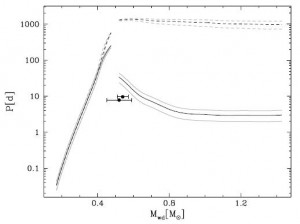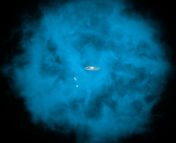• Title: Post-common envelope binaries from SDSS – XVI. Long orbital period systems and the energy budget of CE evolution
• Authors: Rebassa-Mansergas et al.
• First Author’s Institution: Universidad de Valparaiso, Chile
Background
There is no doubt that a high fraction of stars are in binary (or even higher order!) systems. Many of these systems are what we refer to as wide binaries, meaning the stars are far enough apart that neither star affects the evolution of the other. However, this isn’t always the case. For example, one class of binary stars, Algols, is defined by a primary star (the more massive star) which is less evolved than the secondary (the less massive star). If you remember, basic single star evolution tells us the more massive a star is, the more quickly it evolves. The discovery of Algols created the so called Algol paradox, which was ultimately resolved by realizing that when two stars are close enough, one can transfer mass to the other. This suggests the star which is observed to be more massive in the present day was actually the smaller star when the system formed, hence why it has evolved more slowly.
Mass transfer in a binary system is characterized by when a star overflows its Roche lobe. The Roche lobe tell us the point at which the material from one star is more gravitationally attracted to its companion than itself. This material will normally be accreted by the companion to the donor star in a slow and stable manner. In a stable mass transfer case, an accretion disk develops around the accreting star. However, sometimes this mass transfer is unstable because it is occurring at an extremely high rate. In these cases, the overflowing mass builds up so much that is overflows the companions roche lobe as well and engulfs the entire system. This is what we refer to as a common envelope (CE).
No systems have been observed in the CE phase, but there are many binary systems which are believed to be post-CE binaries. This is because CEs are essential to explain close binaries where one member is fully evolved. Let’s think of it in terms of the sun. When the sun evolves to be a red giant, it’s radius will expand by around a factor of 100, completely engulfing the orbit of Mercury. So if we see a white dwarf star which has a sun-like progenitor, and a companion within the orbit of Mercury, we know that it must have been engulfed by the envelope when the white dwarf was a red giant star.
Motivation
The physics of CE evolution is poorly understood. This is because proper modelling of the CE phase requires time consuming 3-dimensional simulations. While efforts are being made in this regard, it is still not feasible to simulate the entire evolution of CE systems. Therefore, it is common to discuss CE evolution in terms of the energy budget of the system. An efficiency parameter, α, is used to characterize the fraction of available orbital energy which is used to expel the CE (since no observable post-CE binaries still have the CE). There has been some disagreement in the literature on whether the orbital energy can possibly provide enough energy to expel the CE, and some researchers believe that energy from another source (most likely recombination energy) is needed. Recombination energy arises if the CE is ionized because ionization energy is released when atoms recombine. The authors of this paper investigate two “long period” post-CE systems to determine whether orbital energy would have been sufficient to explain the ejection of the CE. These longer period systems are of particular interest because they have lost less orbital energy than post-CE systems on shorter period orbits.

Figure 6 from Rebassa-Mansergas et al. This figure shows the orbital period of a post-CE system as a function of white dwarf mass. The black solid line shows a maximum orbital period for the system if all the recombination energy is used to expel the envelope while the dashed line shows the maximum orbital period for the system if only orbital energy contributes to expelling the envelope. If a system were located between the solid and dashed lines it would provide direct evidence that recombination energy had contributed to the evolution of the system; however, neither of the systems presented in this work (plotted with errorbars) meet this criteria.
Observations and Analysis
The authors examine two post-CE binaries selected from the Sloan Digital Sky Survey: SDSSJ 1211-0249 and SDSSJ 2221+0029. Rebassa-Mansergas et al. determine the periods of these systems using the radial velocity technique. Because these are double line spectroscopic binaries, the authors not only know the total mass of both systems, but the mass ratios of the two stars in each system.
The authors then separate out the spectral features of both stars in the system and examine them separately. This separation allows Rebassa-Mansergas et al. to determine the surface gravity (log g), effective temperature (Teff), and mass of the white dwarf, as well as the spectral type, mass, and radius of the secondary if they also use the mass-radius relation for white dwarfs and for m-dwarfs. Once they know the present day constraints on the systems, the authors determine the age of the systems (using white dwarf cooling tracks), and attempt to reconstruct the evolutionary history of the systems.
Results
Rebassa-Mansergas et al. find that the evolution of both of the systems presented in this paper can be understood with only energy contributions from the initial orbital energy of the systems. However, it is important to note that this finding does not rule out energy contributions from recombination energy (or other energy sources). In fact, the authors suggest the high efficiency required (α = 0.42−1) for SDSSJ 2221+0029 suggests another energy source, although this system does not provide direct evidence. See the figure for the constraints on direct evidence.





Trackbacks/Pingbacks